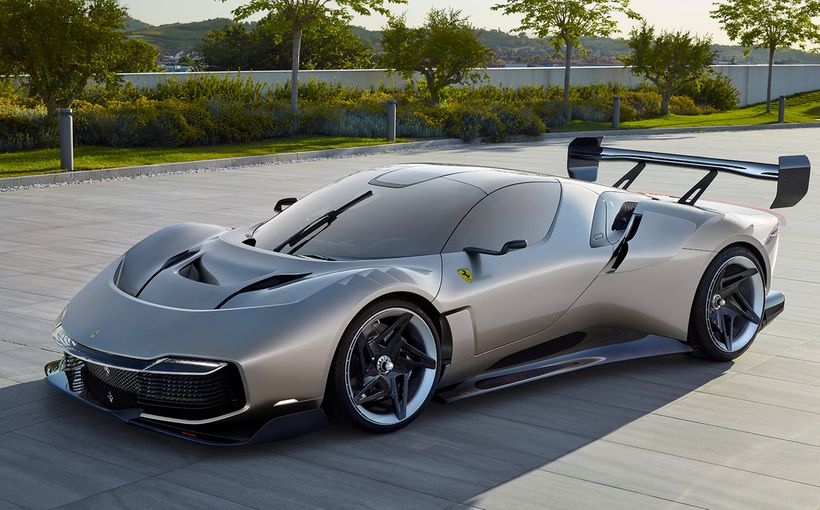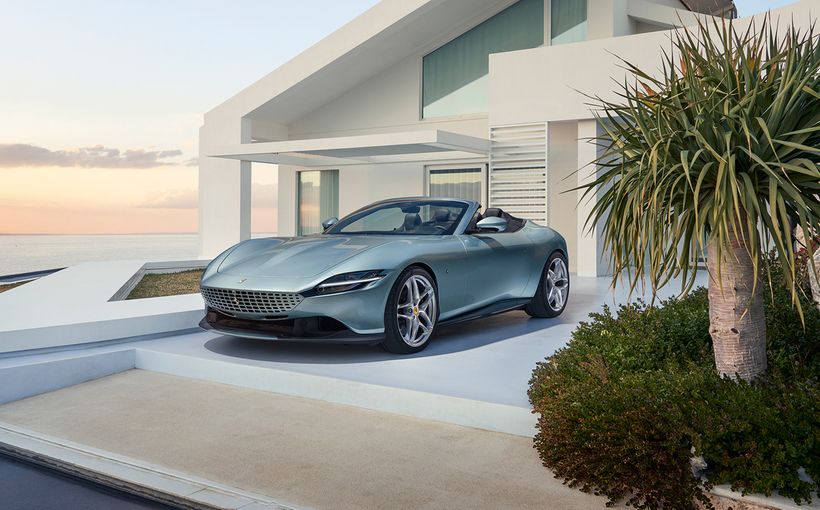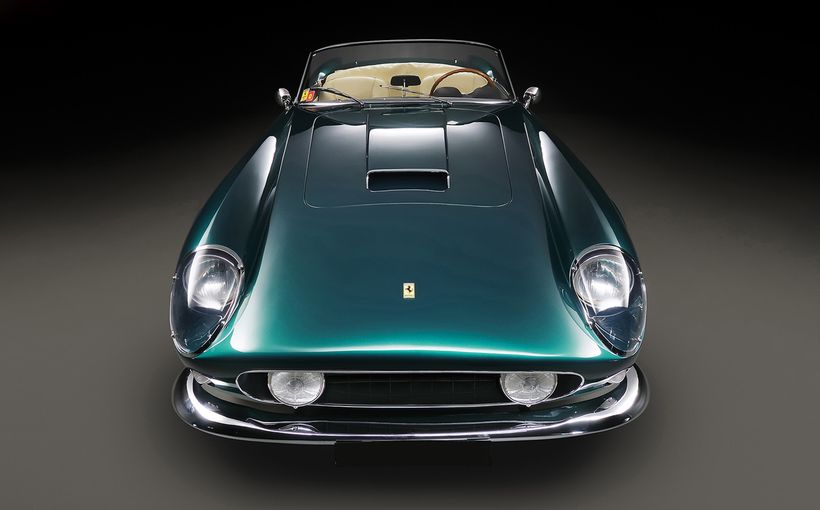Ferrari 512 TR: The Quick and the Red

It’s lighter, more attractive and even more powerful than its predecessor, but it still has all the family traits. That would mean little if it wasn’t for one thing… Gavin Green drives the new Testarossa, the 512 TR.
After three days of storms and non-stop rain, northern Italy was drenched. But fittingly, as we arrived at Fiorano, shafts of sunlight began to pierce the thick cloud and cast an eerie incandescence over our appointment with the latest incarnation of the Ferrari Testarossa- the 512 TR.
Clearly less than the brand new car that had been promised, but looking rather more different than the on-paper details might suggest, the 512 TR is attractive and imposing. The front-end rework is successful, the new wheels and tyres a big aesthetic improvement.
Before driving, I went out with Ferrari's chief test driver Daria Benuzzi, to be shown the way around Fiorano. I had ridden with Benuzzi before, and he is a wonderful driver, like all Maranello testers. We got into an old Testarossa that Ferrari conveniently had on hand.
Whether Benuzzi was feeling off colour or just wasn't in an entertaining mood, I don't know, but by his standards, his performance was ordinary: only one lurid opposite lock slide on the damp surface, no spins (but we went close), and no wheelspinning on the straights. After three laps, he left me to go it alone.
A few laps in the damp in the old Testarossa, time to get reacquainted with the prodigious power of the old flat 12, and with its tricky, poorly balanced handling. Then out of the old, into the new.
It's awkward to climb into the 512 TR's cockpit. The sill is extraordinarily wide, and you have to vault the handbrake and the remote boot and bonnet release levers before you can snuggle into the thicker, more luxurious driver's seat. Move the steering wheel - it's rake rather than reach adjustable - and you can almost get comfortable. The driving position, though, is appalling. Despite the lowered seat, your head is very near the roof lining, and your legs are twisted to the centre line of the car where the pedals are. The pedals themselves are too close to you, the steering wheel is too far away. The old excuse, that powerful mid-engined cars always have awkward driving positions, sounds feeble now Honda has exposed the truth with the NSX.
The centre console is new, and no longer curls up to meet the main dash. The minor instruments are now all located in a little tacked-on leather-lined panel below the dash, in the centre. As before, everything that is not carpeted is skinned in top grade Connolly leather.
The door catch is awkward to reach and to press. Swing the door out, and it seems surprisingly light, considering its size and steel construction. All the other panels, apart from the roof, are aluminium.

Turn the ignition, and you're met by an even better engine note, which becomes a melody as you move off. The 512 TR has noticeably more power, even better tractability and, what's more important, better handling balance. It's still a much harder car to throw around than most hot hatches but, on the limit, there's no doubt it's more manoeuvrable and predictable than the old car. It rolls less, the front and rear ends working in harmony, not at odds. The only disappointment is a tendency to greater initial understeer. As the speed builds, so the handling edges towards neutrality. Keep pressing and oversteer is still the final weapon, to spoil the fun. But whereas the old Testarossa's final oversteer was a mushy, imprecise, roll-induced tail charge, the 512 TR feels much tauter at the back.
The brakes feel strong, if a little dead and lacking in feel. The steering is more precise than on the old car – another important improvement. And the gearchange, so heavy and cumbersome before, has also been fettled: both the change action and the clutch are lighter. Mercifully unchanged is the alloy six fingered gearchange gate and the delicate alloy gearstick.
Not that the engine demands many gearchanges. It is a superb engine, able to pull seamlessly from 750rpm in fifth up to the 6800 redline. It was wonderful in the old Testarossa, but the flat 12 in the new 512 TR is even better, blessed with amazing docility at low revs, yet staggering ferocity at high crank speeds. No-one has ever built a better engine.
Predictably, only 20 minutes after first venturing onto Fiorano, we were given 20 minutes to get off. Apparently, a press conference had been arranged there to announce Ferrari 's new F1 drivers.
We left the track and headed for the mountains near Maranello.
We were given an hour.
On the road, the 512 TR offers quite good all -round vision, even over the shoulder. The clutch and gearchange are still heavy by Golf GTi standards, but feather light beside the Diablo. Mind you, it's still difficult to effect fast changes, particularly in the awkward, doglegged first to second shift.
The steering, muscle-rippingly heavy at low speeds, lightens nicely as the speed builds , offering good feedback and precision. There is less kickback through the wheel than on the old Testarossa, but the gorgeous steering wheel still does a little jig in your hands as you traverse the worst bumps. The whole car feels wonderfully alive, without being nervous.
We climbed into the foothills of the Apennines, the road getting narrower and the turns tighter. Although there's no denying the undiminished bulk of the car the 512 TR does seem to shrink as confidence and speed build.
Through the sweeping, winding roads, the 512 TR was an inspired companion. Big strong brakes grinding down the speed, heel and toe down through the gears, precise steering turn-in, massive kick in the spine as you reapply the throttle. Terrific steering feedback, even at speed on the multi-camber roads, and always exemplary stability, grip and balance. Plough into a corner a little too quickly, back off and the nose obediently tucks into the apex.
The big Ferrari is still hard work to drive hard - it's a very physical car, one that demands both strength and bravery when pressing on. The wonderful noise, and your closeness to the ground, heighten the excitement, pandering to your senses. It's a special experience, fast Testarossa motoring. Never mind that a Golf GTi, on exactly that same stretch of road, would have been going just as fast, and with less effort from its driver. He would not remember it, as I will.

Back to Maranello; a factory tour - watch a Ferrari being built and you'll want one - and a look around the new Ferrari museum which boasts a good collection of road and racing cars, plus trophies and other collectables. Then on to the press conference, where marketing boss Bruno Albino introduced us to four key 512 TR engineers who would explain the new features of the car.
The production man, Vignale- moustachioed , balding and smartly dressed in cords and a check jacket - opened the show. "Although the new 512 TR looks similar to the old Testarossa," he began, "it is a brand new car. " The styling , he added, was carried over virtually unchanged, "to make it clear that the 512 TR comes from the Testarossa family".
Styling differences include new front and rear bumpers, and - the only sheet metal change - a new engine cover. The new front bumper allowed Ferrari to change the grille and the driving lights, to give the 512 TR a 348-esque face. Visually, it's a big improvement. The new engine cover is lower 'and less messily styled than the old car's. Underneath, there is one odd touch: although the engine lid is new, it still wears a Testarossa badge - contradicting the name change.
The rear flying buttresses - part of the engine cover - have a slightly different sweep. The side and rear strakes, such a controversial styling feature of the Testarossa, are carried over unchanged. Overall dimensions are also unchanged - the 512 TR remains a wide car. Weight has been usefully pared, though, by 45kg. Still, 1470kg is a lot for a two seater.
Next up, Amedeo Felisa, the engine/transmission man - shortish, balding, wearing a blue suit. One of the priorities, he said, was to improve the performance. I would have thought that was the last thing needed, given the thundering power of the old Testarossa. Ferrari 's reasoning? It must be to get the company flagship close to the new Diablo, in terms of get up and go.
The new TR doesn't quite manage that, but isn't far away. The factory claims a top speed of 313km/h, and 0-100 in 4.8 seconds. Power rises to 314kW. Torque is the same in terms of maximum output (488Nm), but is stronger across a broader range. A catalyst is now fitted as standard.

Specific engine changes include longer inlet manifolds, a different exhaust (a beautiful, hand-welded device), the adoption of Bosch Motronic fully electronic injection/ignition which replaces the old K-Jetronic electro-mechanical set-up, new pistons and liners, new larger diameter (by 1.25mm) inlet valves, a higher compression ratio (10.0:1, up from 9.3), and re-profiled camshafts to give greater pulling power. The upshot is not only more power, but greater frugality: about 5-1 0 per cent better economy.
Also significant are the smaller, more efficient side radiators. They have liberated room in those vast side ducts for trunking to ram air into the engine; in the old Testarossa, the induction air was sucked in from the back. Ferrari even talks of a slight supercharging effect.
The transmission - which still sits below the engine - has a single rather than a twin plate clutch, and minor alterations to the synchromesh.
Probably the most important bit of powertrain news is not what's inside that gorgeous 4.9 litre flat 12 engine – with those vast curling inlet tracts looking like an athlete's ribcage - but its positioning. The powertrain is now about 25mm lower, a change made feasible by the new exhaust system. This lowers the centre of gravity, improving handling and responsiveness. Nonetheless, the fact that the transaxle remains below the engine means the crankshaft is still higher than ideal.
Onto the stage walked Roberto Corradi - fair skinned, light brown hair, and looking like a bigger version of Robin Williams. With his Anglo-Saxon looks, came Anglo-Saxon reserve: he was rather more shy than the others, less of a showman. All the same, as chassis and suspension expert, he told us that the spaceframe chassis has greater torsional strength, thanks to the use of oval tubes in the centre section (as on the F40). Unsprung weight has been usefully reduced, by using aluminium alloy hubs.
The front and rear wishbones are said to be more rigid, and the springs and dampers are stiffer front and rear (as on the old Testarossa, twin spring/damper units are used on each side at the back). Greater rear camber change is possible, which helps roadholding- because it enables the tyres to stay flat with the ground as the car rolls. And the roll angle, helped by the stiffer springing, wider tyres and lower centre of gravity, has been reduced.
The disc brakes, still internally ventilated but now boasting cross drilling as well to help both the looks and heat dissipation, are bigger than before. They in turn keep a grip on exceedingly handsome new 18 inch diameter alloy wheels, rolling within new, vast tyres.
Pirelli, Bridgestone, Michelin and Goodyear brands are all on offer - 235/40s at the front, 295/35s at the rear.

We used Pirelli P Zeros.
Maurizio Manfredini, small, greying, and another fan of English checked jackets, is in charge of testing. He told us that the steering of the new TR is now sharper than before (3.25 turns lock to lock instead of 3.4), that the scrub radius is reduced, the self-alignment is better, and that the brakes can withstand 10 laps flat-out around Fiorano without fading. Stamp on the pedal at 200km/h, said Manfredini, and you'll stop 20 metres shy of the old car.
At 9.00am the following morning, Bruno Albino was due to arrive in a 512 TR , destination Mugello. Just before the appointed hour, on a warm sunny day, the efficient marketing man duly turned up, accompanied by two young Italian studs - swarthy skinned, colourful anoraks, jeans, slicked-back hair, big Roman noses - who were introduced as 'test drivers'. Their purpose was never clear.
The four car convoy headed for Mugello, across the flat Emilian plains, and up into the Apennines, where the new hi-tech circuit resides.
A few more on-road impressions. At speed, on the autostrada, the car is surprisingly restful , the engine producing a muted bellow behind your spine. Only under hard acceleration does the note intrude - and then it doesn't so much intrude as serenade. Wind and road noise are surpri singly well suppressed, although our car had a rather nasty gush around its big driver's wing mirror. The mirrors, looking like huge red rodent's ears, are carried over from the old model.
The ride, too, is surprisingly good for a car wearing such big tyres, and so firmly suspended. The new 18 inch tyres run at lower pressure than their 16 inch predecessors; Ferrari claims this helps suppleness. Directional stability, no doubt assisted by the vast tyres, is excellent. This really is a supercar that could be used painlessly on long freeway journeys Well, fairly painlessly. The twin blights are the daft driving position, which is not so much uncomfortable as annoying, and the (still) poor seats. More headroom would be welcome, too.
L'Autodromo del Mugello must have the most beautiful location of any purpose- built racing track in Europe. In Tuscany's Mugello val ley, 32km northeast of Florence, it is ringed by mountains, trees and farmhouses. Soon after we arrived, it was bathed in the lovely gentle light for which the area is famous.

Upwards of $45 million has just been spent on the circuit, partly to equip it for international motor racing events, partly to help Ferrari with its private F1 testing. Mugello was specially modified for Ferrari. With facilities such as this, why can't the scuderia win?
Never mind F1. The two day exercise was to see whether Ferrari had at last succeeded with the Testarossa, a flawed car, and one that never stood comfortably in the footsteps of the old Boxer it supplanted. It has.
The 512 TR is still weak in many ways. It's too wide (at the expense of agility), too uncomfortable, and the handling is sti ll less benign and less entertaining than the NSX's. But given the similarities between the new one and the old, and the obvious restrictions the engineers faced, Ferrari has certainly succeeded. If I had the choice, I'd still prefer a 348, for its manoeuvrability and looks. But there'd always be times, as I enjoyed my 348, that I would wistfully dream of the 512 TR and its greatest asset - that intoxicating flat 12, its noise and muscle. There has never been a more sublime engine - enough to make a good car great.
Go Back in time with the Wheel Archive. Get FREE access to 5 years of Wheels archive content now!  Protect your Classic. Call Shannons Insurance on 13 46 46 to get a quote today.
Protect your Classic. Call Shannons Insurance on 13 46 46 to get a quote today.









